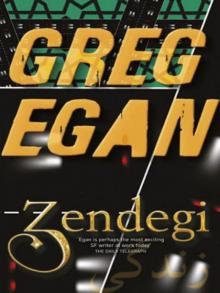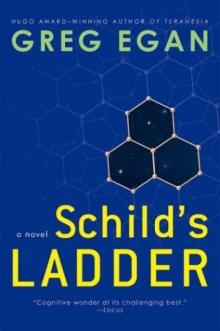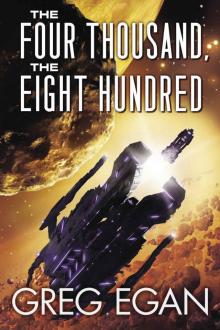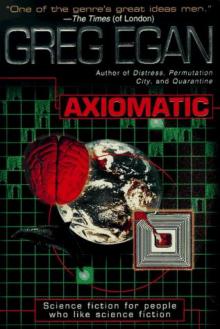Luminous Read online
Page 9
I watched, light-headed. Obscure, but supposedly eternal, truths were tumbling like chess pieces. ‘And … you think that physical processes going on right now – chance molecular events which keep inadvertently testing and re-testing different theories along the border – cause each side to gain and lose territory?’
‘Yes.’
‘So there’s been a kind of … random tide washing back and forth between the two kinds of mathematics, for the past few billion years?’ I laughed uneasily, and did some rough calculations in my head. ‘The expectation value for a random walk is the square root of N. I don’t think we have anything to worry about. The tide isn’t going to wash over any useful arithmetic in the lifetime of the universe.’
Alison smiled humourlessly, and held up the notepad again. ‘The tide? No. But it’s the easiest thing in the world to dig a channel. To bias the random flow.’ She ran an animation of a sequence of tests which forced the far-side system to retreat across a small front – exploiting a ‘beach-head’ formed by chance, and then pushing on to undermine a succession of theorems. ‘Industrial Algebra, though, I imagine, would be more interested in the reverse. Establishing a whole network of narrow channels of non-standard mathematics running deep into the realm of conventional arithmetic – which they could then deploy against theorems with practical consequences.’
I fell silent, trying to imagine tendrils of contradictory arithmetic reaching down into the everyday world. No doubt IA would aim for surgical precision, hoping to earn themselves a few billion dollars by corrupting the specific mathematics underlying certain financial transactions. But the ramifications would be impossible to predict – or control. There’d be no way to limit the effect, spatially. They could target certain mathematical truths, but they couldn’t confine the change to any one location. A few billion dollars, a few billion neurons, a few billion stars … a few billion people. Once the basic rules of counting were undermined, the most solid and distinct objects could be rendered as uncertain as swirls of fog. This was not a power I would have entrusted to a cross between Mother Teresa and Carl Friedrich Gauss.
‘So what do we do? Erase the map and just hope that IA never find the defect for themselves?’
‘No.’ Alison seemed remarkably calm – but then, her own long-cherished philosophy had just been confirmed, not razed to the ground, and she’d had time on the flight from Zürich to think through all the Realmathematik. ‘There’s only one way to be sure that they can never use this. We have to strike first. We have to get hold of enough computing power to map the entire defect. And then we either iron the border flat, so it can’t move: if you amputate all the pincers, there can be no pincer movements. Or – better yet, if we can get the resources – we push the border in, from all directions, and shrink the far-side system down to nothing.’
I hesitated. ‘All we’ve mapped so far is a tiny fragment of the defect. We don’t know how large the far side could be. Except that it can’t be small, or the random fluctuations would have swallowed it long ago. And it could go on for ever; it could be infinite, for all we know.’
Alison gave me a strange look. ‘You still don’t get it, do you, Bruno? You’re still thinking like a Platonist. The universe has only been around for fifteen billion years. It hasn’t had time to create infinities. The far side can’t go on for ever, because somewhere beyond the defect there are theorems which don’t belong to any system. Theorems which have never been touched, never been tested, never been rendered true or false.
‘And if we have to reach beyond the existing mathematics of the universe in order to surround the far side … then that’s what we’ll do. There’s no reason why it shouldn’t be possible, just so long as we get there first.’
* * *
When Alison took my place, at one in the morning, I was certain I wouldn’t get any sleep. When she shook me awake three hours later, I still felt as though I hadn’t.
I used my notepad to send a priming code to the data caches buried in our veins, and then we stood together side by side, left shoulder to right shoulder. The two chips recognised each other’s magnetic and electrical signatures, interrogated each other to be sure, and then began radiating lower power microwaves. Alison’s notepad picked up the transmission, and merged the two complementary data streams. The result was still heavily encrypted, but, after all the precautions we’d taken so far, shifting the map into a hand-held computer felt about as secure as tattooing it onto our foreheads.
A taxi was waiting for us downstairs. The People’s Institute for Advanced Optical Engineering was in Minhang, a sprawling technology park some thirty kilometres south of the city centre. We rode in silence through the grey pre-dawn light, past the giant ugly tower blocks thrown up by the landlords of the new millennium, riding out the fever as the necrotraps and their cargo dissolved into our blood.
As the taxi turned into an avenue lined with biotech and aerospace companies, Alison said, ‘If anyone asks, we’re PhD students of Yuen’s, testing a conjecture in algebraic topology.’
‘Now you tell me. I don’t suppose you have any specific conjecture in mind? What if they ask us to elaborate?’
‘On algebraic topology? At five o’clock in the morning?’
The Institute building was unimposing – sprawling black ceramic, three storeys high – but there was a five-metre electrified fence, and the entrance was guarded by two armed soldiers. We paid the taxi driver and approached on foot. Yuen had supplied us with visitor’s passes, complete with photographs and fingerprints. The names were our own; there was no point indulging in unnecessary deception. If we were caught out, pseudonyms would only make things worse.
The soldiers checked the passes, then led us through an MRI scanner. I forced myself to breathe calmly as we waited for the results; in theory, the scanner could have picked up our symbionts’ foreign proteins, lingering breakdown products from the necro-traps, and a dozen other suspicious trace chemicals. But it all came down to a question of what they were looking for; magnetic resonance spectra for billions of molecules had been catalogued, but no machine could hunt for all of them at once.
One of the soldiers took me aside and asked me to remove my jacket. I fought down a wave of panic and then struggled not to overcompensate: if I’d had nothing to hide, I would still have been nervous. He prodded the bandage on my upper arm; the surrounding skin was still red and inflamed. ‘What’s this?’
‘I had a cyst there. My doctor cut it out, this morning.’
He eyed me suspiciously, and peeled back the adhesive bandage with ungloved hands. I couldn’t bring myself to look; the repair cream should have sealed the wound completely – at worst there should have been old, dried blood – but I could feel a faint liquid warmth along the line of the incision.
The soldier laughed at my gritted teeth, and waved me away with an expression of distaste. I had no idea what he thought I might have been hiding, but I saw fresh red droplets beading the skin before I closed the bandage.
Yuen Ting-fu was waiting for us in the lobby. He was a slender, fit-looking man in his late sixties, casually dressed in denim. I let Alison do all the talking: apologising for our lack of punctuality (although we weren’t actually late), and thanking him effusively for granting us this precious opportunity to pursue our unworthy research. I stood back and tried to appear suitably deferential. Four soldiers looked on impassively; they didn’t seem to find all this grovelling excessive. And no doubt I would have been giddy with awe if I really had been a student granted time here for some run-of-the-mill thesis.
We followed Yuen as he strode briskly through a second check-point and scanner (this time, no one stopped us), then down a long corridor with a soft grey vinyl floor. We passed a couple of white-coated technicians, but they barely gave us a second glance. I’d had visions of a pair of obvious foreigners attracting as much attention here as we would have done wandering through a military base, but that was absurd. Half the runtime on Luminous was sold to foreign corpo
rations – and because the machine was most definitely not linked to any communciations network, commercial users had to come here in person. Just how often Yuen wangled free time for his students – whatever their nationality – was another question, but if he believed it was the best cover for us, I was in no position to argue. I only hoped he’d planted a seamless trail of reassuring lies in the University records and beyond, in case the Institute administration decided to check up on us in any detail.
We stopped in at the operations room, and Yuen chatted with the technicians. Banks of flatscreens covered one wall, displaying status histograms and engineering schematics. It looked like the control centre for a small particle accelerator – which wasn’t far from the truth.
Luminous was, literally, a computer made of light. It came into existence when a vacuum chamber, a cube five metres wide, was filled with an elaborate standing wave created by three vast arrays of high-powered lasers. A coherent electron beam was fed into the chamber – and just as a finely machined grating built of solid matter could diffract a beam of light, a sufficiently ordered (and sufficiently intense) configuration of light could diffract a beam of matter.
The electrons were redirected from layer to layer of the light cube, recombining and interfering at each stage, every change in their phase and intensity performing an appropriate computation – and the whole system could be reconfigured, nanosecond by nanosecond, into complex new ‘hardware’ optimised for the calculations at hand. The auxiliary supercomputers controlling the laser arrays could design, and then instantly build, the perfect machine of light to carry out each particular stage of any program.
It was, of course, fiendishly difficult technology, incredibly expensive and temperamental. The chance of ever putting it on the desktops of Tetris-playing accountants was zero, so nobody in the West had bothered to pursue it.
And this cumbersome, unwieldy, impractical machine ran faster than all the pieces of silicon hanging off the Internet, combined.
We continued on to the programming room. At first glance, it might have been the computing centre in a small primary school, with half a dozen perfectly ordinary work stations sitting on white Formica tables. They just happened to be the only six in the world which were hooked up to Luminous.
We were alone with Yuen now. Alison cut the protocol and just glanced briefly in his direction for approval, before hurriedly linking her notepad to one of the work stations and uploading the encrypted map. As she typed in the instructions to decode the file, all the images running through my head of what would have happened if I’d poisoned the soldier at the gate receded into insignificance. We now had half an hour to banish the defect, and we still had no idea how far it extended.
Yuen turned to me; the tension on his face betrayed his own anxieties, but he mused philosophically, ‘If our arithmetic seems to fail for these large numbers, does it mean the mathematics, the ideal, is really flawed and mutable, or only that the behaviour of matter always falls short of the ideal?’
I replied, ‘If every class of physical objects ‘‘falls short’’ in exactly the same way, whether it’s boulders or electrons or abacus beads, what is it that their common behaviour is obeying – or defining – if not the mathematics?’
He smiled, puzzled. ‘Alison seemed to think you were a Platonist.’
‘Lapsed. Or … defeated. I don’t see what it can mean to talk about standard number theory still being true for these statements – in some vague Platonic sense – if no real objects can ever reflect that truth.’
‘We can still imagine it. We can still contemplate the abstraction. It’s only the physical act of validation that must fall through. Think of transfinite arithmetic: no one can physically test the properties of Cantor’s infinities, can they? We can only reason about them from afar.’
I didn’t reply. Since the revelations in Hanoi, I’d pretty much lost faith in my power to ‘reason from afar’ about anything I couldn’t personally describe with Arabic numerals on a single sheet of paper. Maybe Alison’s idea of ‘local truth’ was the most we could hope for; anything more ambitious was beginning to seem like the comic-book ‘physics’ of swinging a rigid beam ten billion kilometres long around your head, and predicting that the far end would exceed the speed of light.
An image blossomed on the work-station screen: it began as the familiar map of the defect, but Luminous was already extending it at a mind-boggling rate. Billions of inferential loops were being spun around the margins: some confirming their own premises, and thus delineating regions where a single, consistent mathematics held sway; others skewing into self-contradiction, betraying a border crossing. I tried to imagine what it would have been like to follow one of those Möbiusstrips of deductive logic in my head; there were no difficult concepts involved, it was only the sheer size of the statements which made that impossible. But would the contradictions have driven me into gibbering insanity, or would I have found every step perfectly reasonable, and the conclusion simply unavoidable? Would I have ended up calmly, happily conceding: Two and two make five?
As the map grew – smoothly re-scaled to keep it fitting on the screen, giving the unsettling impression that we were retreating from the alien mathematics as fast as we could, and only just avoiding being swallowed – Alison sat hunched forward, waiting for the big picture to be revealed. The map portrayed the network of statements as an intricate lattice in three dimensions (a crude representational convention, but it was as good as any other). So far, the border between the regions showed no sign of overall curvature, just variously sized random incursions in both directions. For all we knew, it was possible that the far-side mathematics enclosed the near side completely, that the arithmetic we’d once believed stretched out to infinity was really no more than a tiny island in an ocean of contradictory truths.
I glanced at Yuen; he was watching the screen with undisguised pain. He said, ‘I read your software, and I thought: Sure, this looks fine, but some glitch on your machines is the real explanation. Luminous will soon put you right.’
Alison broke in jubilantly, ‘Look, it’s turning!’
She was right. As the scale continued to shrink, the random fractal meanderings of the border were finally being subsumed by an overall convexity – a convexity of the far side. It was as if the viewpoint was backing away from a giant spiked sea-urchin. Within minutes, the map showed a crude hemisphere, decorated with elaborate crystalline extrusions at every scale. The sense of observing some palaeomathematical remnant was stronger than ever now: this bizarre cluster of theorems really did look as if it had exploded out from some central premise into the vacuum of unclaimed truths, perhaps a billionth of a second after the Big Bang, only to be checked by an encounter with our own mathematics.
The hemisphere slowly extended into a three-quarters sphere … and then a spiked whole. The far side was bounded, finite. It was the island, not us.
Alison laughed uneasily. ‘Was that true before we started, or did we just make it true?’ Had the near side enclosed the far side for billions of years, or had Luminous broken new ground, actively extending the near side into mathematical territory which had never been tested by any physical system before?
We’d never know. We’d designed the software to advance the mapping along a front in such a way that any unclaimed statements would be instantly recruited into the near side. If we’d reached out blindly, far into the void, we might have tested an isolated statement – and inadvertently spawned a whole new alternative mathematics to deal with.
Alison said, ‘OK, now we have to decide. Do we try to seal the border or do we take on the whole structure?’
The software, I knew, was busy assessing the relative difficulty of the tasks.
Yuen replied at once, ‘Seal the border, nothing more. You mustn’t destroy this.’ He turned to me, imploringly. ‘Would you smash up a fossil of Australopithecus? Would you wipe the cosmic background radiation out of the sky? This may shake the foundations of all my beliefs,
but it encodes the truth about our history. We have no right to obliterate it, like vandals.’
Alison eyed me nervously. What was this, majority rule? Yuen was the only one with any power here; he could pull the plug in an instant. And yet it was clear from his demeanour that he wanted a consensus; he wanted our moral support for any decision.
I said cautiously, ‘If we smooth the border, that’ll make it literally impossible for IA to exploit the defect, won’t it?’
Alison shook her head. ‘We don’t know that. There may be a quantum-like component of spontaneous defections, even for statements which appear to be in perfect equilibrium.’
Yuen countered, ‘Then there could be spontaneous defections anywhere, even far from any border. Erasing the whole structure will guarantee nothing.’
‘It will guarantee that IA won’t find it! Maybe pinpoint defections do occur, all the time, but the next time they’re tested they’ll always revert. They’re surrounded by explicit contradictions; they have no chance of getting a foothold. You can’t compare a few transient glitches with this … armoury of counter-mathematics!’
The defect bristled on the screen like a giant caltrap. Alison and Yuen both turned to me expectantly. As I opened my mouth, the work station chimed. The software had examined the alternatives in detail: destroying the entire far side would take Luminous twenty-three minutes and seventeen seconds – about a minute less than the time we had left. Sealing the border would take more than an hour.
I said, ‘That can’t be right.’
Alison groaned. ‘But it is! There’s random interference going on at the border from other systems all the time – and doing anything finicky there means coping with that noise, fighting it. Charging ahead and pushing the border inwards is different: you can exploit the noise to speed the advance. It’s not a question of dealing with a mere surface versus dealing with a whole volume. It’s more like … trying to carve an island into an absolutely perfect circle while waves are constantly crashing on the beach – versus bulldozing the whole thing into the ocean.’

 Zendegi
Zendegi Permutation City
Permutation City The Eternal Flame
The Eternal Flame Artifacts
Artifacts Wang's Carpets
Wang's Carpets Dichronauts
Dichronauts Incandescence
Incandescence Teranesia
Teranesia Schild's Ladder
Schild's Ladder Quarantine
Quarantine The Four Thousand, the Eight Hundred
The Four Thousand, the Eight Hundred The Clockwork Rocket
The Clockwork Rocket Zeitgeber
Zeitgeber Phoresis
Phoresis The Nearest
The Nearest Diaspora
Diaspora Instantiation
Instantiation Distress
Distress An Unusual Angle
An Unusual Angle Oceanic
Oceanic The Arrows of Time
The Arrows of Time Axiomatic
Axiomatic![Anthology 2. Luminous [1998, 2010] Read online](http://i1.bookreadfree.com/i/03/18/anthology_2_luminous_1998_2010_preview.jpg) Anthology 2. Luminous [1998, 2010]
Anthology 2. Luminous [1998, 2010] Perihelion Summer
Perihelion Summer Luminous
Luminous